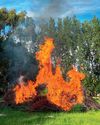Poging GOUD - Vrij
Uneasy atmosphere
New Zealand Listener
|October 22, 2022
Rethinking urban planting and better air monitoring for pollen and spores could help reduce symptoms for seasonal hay fever sufferers.

The warm, wet winter has meant hay fever season arrived early this year and pollen counts are forecast to be high. For about 20% of New Zealanders that means dealing with unpleasant symptoms, such as itchy and watery eyes, frequent sneezing, headaches and dizziness, sore throats and blocked noses.
Urban hay fever sufferers often blame the surrounding countryside for their symptoms, but the latest research suggests that may not be the case.
Philip Taylor, of La Trobe University in Melbourne, was part of a team of international scientists who have studied how far hay fever causing particles such as pollen and fungi can travel in the atmosphere.
They took air samples at the Amazon Tall Tower Observatory, a base in the middle of the rainforest of northern Brazil which has two research masts, the taller of which is 325m.
"It's the last pristine air on the planet," Taylor says.
Clouds of Saharan dust have been detected there, having blown thousands of kilometres across the Atlantic Ocean.
However, pollen particles are bigger, and the team's sampling showed that rather than rising into the air and scattering over long distances, pollen tends to travel low to the ground.
These giant aerosols generally don't achieve the height required for long-range transport, explains Taylor. "You need a lot of atmospheric force, a convective storm [strong thunderstorm] to make that happen."
Biophysics is telling us that the causes of urban hay fever are most likely to be closer to home, and Taylor points to ryegrass as a particular problem. We use it in our city gardens, parks and sports grounds, as well as in rural areas for animals to graze on.
Dit verhaal komt uit de October 22, 2022-editie van New Zealand Listener.
Abonneer u op Magzter GOLD voor toegang tot duizenden zorgvuldig samengestelde premiumverhalen en meer dan 9000 tijdschriften en kranten.
Bent u al abonnee? Aanmelden
MEER VERHALEN VAN New Zealand Listener

New Zealand Listener
Down to earth diva
One of the great singers of our time, Joyce DiDonato is set to make her New Zealand debut with Berlioz.
8 mins
29 November-December 5 2025

New Zealand Listener
Tamahori in his own words
Opening credits
5 mins
29 November-December 5 2025

New Zealand Listener
Thought bubbles
Why do chewing gum and doodling help us concentrate?
3 mins
29 November-December 5 2025

New Zealand Listener
The Don
Sir Donald McIntyre, 1934-2025
2 mins
29 November-December 5 2025

New Zealand Listener
I'm a firestarter
Late spring is bonfire season out here in the sticks. It is the time of year when we rural types - even we half-baked, lily-livered ones who have washed up from the city - set fire to enormous piles of dead wood, felled trees and sundry vegetation that have been building up since last summer, or perhaps even the summer before.
2 mins
29 November-December 5 2025

New Zealand Listener
Salary sticks
Most discussions around pay equity involve raising women's wages to the equivalent of men's. But there is an alternative.
3 mins
29 November-December 5 2025

New Zealand Listener
THE NOSE KNOWS
A New Zealand innovation is clearing the air for hayfever sufferers and revolutionising the $30 billion global nasal decongestant market.
2 mins
29 November-December 5 2025

New Zealand Listener
View from the hilltop
A classy Hawke's Bay syrah hits all the right notes to command a high price.
2 mins
29 November-December 5 2025

New Zealand Listener
Speak easy
Much is still unknown about the causes of stuttering but researchers are making progress on its genetic origins.
3 mins
29 November-December 5 2025

New Zealand Listener
Recycling the family silver?
As election year looms, National is looking for ways to pay for its inevitable promises.
4 mins
29 November-December 5 2025
Translate
Change font size

